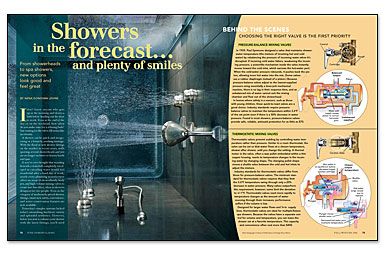Showers in the Forecast
From showerheads to spa showers, new options look good and feel great.

Synopsis: It may be called a bathroom, but for most of us, a bath is a quaint luxury that eats up too much time. Along with coffee and a bagel, it’s the shower that brings us to life every morning. In this survey of the showery landscape, kitchen and bath designer Nena Donovan Levine tells what to look for in a shower valve to make sure it will deliver the desired amount of water, within a scald-free temperature range. If you’re on a budget, learn what to look for to get the most for your dollar. If not, see what luxury awaits in the over $1000 category. A sidebar on shower heads runs down the specifics on low-flow shower heads and handheld wands that can be retrofitted in the time it takes to toast the bagel.
I don’t know anyone who gets up in the morning and draws a bath before heading out the door to work. Even at the end of the day or on the weekend, how often do you make time for a relaxing bath? Just waiting for the tub to fill seems like an eternity.
A shower can be quick and invigorating or a leisurely, soothing massage. With the flood of new shower fittings on the market in recent years, stalls sporting several showerheads and jets are no longer exclusive to luxury hotels and spas.
If you’ve ever thought that standing beneath a waterfall completely enveloped in cascading water would feel wonderful after a hard day of work, nearly every plumbing manufacturer offers an array of showerheads, body jets, and high-volume mixing valves to create just this effect, often in showers designed for two people. Even in the category of moderately priced shower fittings, smart new safety, convenience, and water-conservation features are now available.
Yesterday’s simpler systems lacked today’s astonishing hardware variety and splendid aesthetics. However, before you start to enhance your shower with the latest fittings, you’ll need to focus on the less-glamorous plumbing hidden in the bathroom wall.
What you don’t see can hurt you
The mixing valve is at the heart of every shower system. This valve controls the separate incoming hot- and cold-water flows so that they emerge from the mixing chamber at the temperature you expect. Mixing valves are not just a matter of comfort, however. They protect against scalding. Since the 1970s, the American Society of Sanitary Engineers (ASSE), a plumbing-industry group, has set performance criteria for mixing valves. The present standard (ASSE 1016) dictates that a mixing valve must limit temperature swings to +/-3.6°F.
New single-handle controls also are less of a scalding hazard than the separate hot and cold taps of yore. Balancing the hot and cold inputs for a comfortable temperature is easier, and an adjustable stop on the shower handle limits the handle turn to keep water below uncomfortable temperatures.
The mixing valve is your shower’s engine
The basic foundation of the mixing valve is the “rough,” or housing. Think of it as the mixing valve’s engine block, where water from the hot and cold supply lines is mixed and distributed to the showerheads and tub filler. Buried in the wall behind tile or fiberglass, the rough is a critical interchange that must not fail. Choose a brass rough. Although cast brass is good, forged brass eliminates the possibility of pinhole leaks.
If the rough is the engine block, then the cartridge is the fuel injector. Housed within the rough, the cartridge dictates how the shower will respond to adjustments of temperature and flow and to unexpected changes in water supply. High-quality cartridges have brass, bronze, and/or stainless-steel parts. You should shy away from cartridges with plastic components.
For more photos, drawings, and details, click the View PDF button below:
Fine Homebuilding Recommended Products
Fine Homebuilding receives a commission for items purchased through links on this site, including Amazon Associates and other affiliate advertising programs.

Get Your House Right: Architectural Elements to Use & Avoid

Not So Big House

Graphic Guide to Frame Construction

























